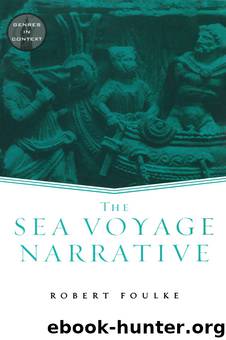The Sea Voyage Narrative by Foulke Robert;

Author:Foulke, Robert; [Robert Foulke]
Language: eng
Format: epub
ISBN: 9781135366506
Publisher: Taylor & Francis Group
Moby-Dick; or, The Whale
From the opening words of Moby-Dick—”Call me Ishmael”—and the incessant strings of Biblical and mythological names throughout the novel, we know we have entered a narrative with ambitions far beyond recording the realities of whaleship life, although it does that too in a highly stylized manner. In terms of pure information, the novel is encyclopedic, providing not only anatomical and taxonomic information about whales but also detailed descriptions of every phase of the practice of whaling, from equipment to technique; indeed, many readers have used this material in the book as a manual on whaling. But this is only one dimension of Moby-Dick. “He who would follow Ishmael must exert the symbolic imagination, for Ishmael’s ‘pursuit’ of the whale is the evolution of an image” writes Charles Feidelson Jr., yet we are neither voyaging in the world of Coleridge’s Ancient Mariner nor trapped between the parallel lines of real events and allegorical signification.10 Warner Berthoff distinguishes four substantive contexts or “worlds” in the novel: 1) “dry land, or at least the thronged edges of it”; 2) “the quaint, rare, old, noble, trophy-garnished, battle-worn, cannibalistic, melancholy Pequod… a fit instrument for Ahab and his purpose”; 3) “the non-human world of the sea and the indifferent elements”; and 4) “the ‘world’ of the unknown and inscrutable” as conceived in sailors’ folklore.11 Symbolic yet substantive, dramatic yet detailed, and constantly linking unseen with seen worlds, Moby-Dick has always remained an enigma for those who try to capture meanings that never hold still. The elements of romance and anatomy described above are pointers, not containers; no more than Moby-Dick can the book itself be caught, cut up, and rendered for interpretive consumption.
In Moby-Dick the cues to the progress of the quest lie quite near the surface of the text, sometimes leaping out of it, and they are enhanced by an archaic and exuberant rhetoric. But, as often happens when the encyclopedic impulse is loosed in big books like Sterne’s Tristram Shandy or Joyce’s Ulysses, narrative elements rarely appear in stark isolation. Here they are surrounded and mixed not only with erudition but also with generous doses of meditation, a way of interrupting the chronological sequence of events that is almost inescapable in voyage narratives. At sea other fictional devices like flashbacks or juxtaposed scenes that create unexpressed implications are often artificial or awkward; ships do crawl along time lines, plotted day by day on their charts, and the scene is always locked on board or at least confined within the visible horizon. As we have seen in chapter 1, expanding the implications of events through meditation is highly developed in many voyage narratives, including Dana’s Two Years before the Mast. Thus it is not surprising that in “Loomings” Moby-Dick begins with Ishmael’s invocation not to the muse but to meditation:
Let the most absent-minded of men be plunged in his deepest reveries—stand that man on his legs, set his feet a-going, and he will infallibly lead you to water, if water there be in all that region.
Download
This site does not store any files on its server. We only index and link to content provided by other sites. Please contact the content providers to delete copyright contents if any and email us, we'll remove relevant links or contents immediately.
4 3 2 1: A Novel by Paul Auster(11783)
The handmaid's tale by Margaret Atwood(7445)
Giovanni's Room by James Baldwin(6803)
Asking the Right Questions: A Guide to Critical Thinking by M. Neil Browne & Stuart M. Keeley(5355)
Big Magic: Creative Living Beyond Fear by Elizabeth Gilbert(5348)
Ego Is the Enemy by Ryan Holiday(4950)
On Writing A Memoir of the Craft by Stephen King(4658)
The Body: A Guide for Occupants by Bill Bryson(4578)
Ken Follett - World without end by Ken Follett(4441)
Bluets by Maggie Nelson(4258)
Adulting by Kelly Williams Brown(4230)
Eat That Frog! by Brian Tracy(4147)
Guilty Pleasures by Laurell K Hamilton(4114)
White Noise - A Novel by Don DeLillo(3828)
The Poetry of Pablo Neruda by Pablo Neruda(3813)
Fingerprints of the Gods by Graham Hancock(3731)
Alive: The Story of the Andes Survivors by Piers Paul Read(3725)
The Book of Joy by Dalai Lama(3692)
The Bookshop by Penelope Fitzgerald(3615)
